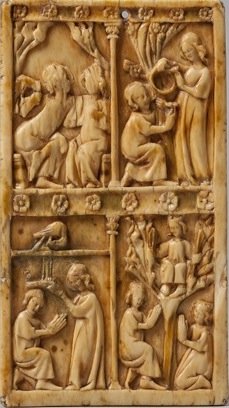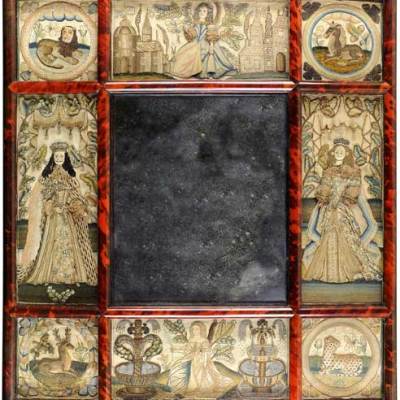The market in gothic ivories has reached a crossroads. These statues and relief panels may be devotional or secular objects, and are carved mostly from African elephant ivory (though examples fashioned from walrus tusk may also be seen). The majority originate in France and adjacent parts of Europe, and date from the mid 13th to the mid 16th century. In many ways the field is on a high, with a host of recent books and international conferences – from London to Kalamazoo, Michigan – shedding new light on this traditionally obscure field. The Gothic Ivories Project founded by the Courtauld Institute of Art in 2008 is flourishing, with a publicly accessible online database of known ivories, and last year saw the publication of John Lowden’s catalogue raisonné of the medieval and later ivories in the Courtauld collection. Another publishing milestone is Medieval Ivory Carvings 1200–1550 by Paul Williamson and Glyn Davies, the first comprehensive catalogue of the ivory holdings of the Victoria and Albert Museum since 1929. It hit shelves on 1 July and has, says London dealer Sam Fogg, ‘transformed the subject’.
The Gustav Rau Triptych, 1310–20, Master of the Amiens Triptych. Sold at Sotheby’s London in July 2013 for £2.8m

Sotheby’s London has also seen staggering prices in recent times, notably the £2.8m (estimate £2.5m–£3.5m) achieved for the Gustav Rau Triptych in July last year. Surviving from early 14th-century France, this elaborately carved piece features scenes from the death of the Virgin, and is given to the Master of the Amiens Triptych. Another extraordinary result for the auction house was the £2.5m (more than twice the high estimate) realised in December for the early Virgin and Child Enthroned (Mosan or northern French). These prices have only been bettered by the Dormeuil Diptych, a French passion diptych dated around 1350–75. It sold at Sotheby’s Paris in November 2007 for just over €4m, and is now in the Thomson Collection at the Art Gallery of Ontario. (Newspaper magnate Ken Thomson’s son David is one of a handful of the mostly European or North American collectors at the top of the market, who compete at auction while also supporting research and museums.)
In February, however, the United States government published a new proposal as part of its National Strategy for Combating Wildlife Trafficking, banning commercial imports of African ivory of any age – including antiques, which were previously exempt. While the bill has not yet become law, in practice the import of ivory into the US has ceased overnight, and the country has just vanished from the international market. Moreover, it specifies that domestic and export trade is limited to artefacts more than 100 years old. While this includes gothic ivories,
the onus is on the seller to prove the age of a piece beyond doubt – a convoluted process that often requires both federal and state licences. A spokeswoman from Christie’s New York sums the situation up thus: ‘This is not a category generally sold within the US, in keeping with current New York legislation which prohibits the sale of any item containing more than 20% of ivory by volume.’
Historically America has been a big player in this field. As Anthony Blumka, a long-established New York dealer, points out, during the 1930s and 1940s gothic ivories were heavily collected in the States, with the result that the Metropolitan Museum of Art and other institutions have some of the finest holdings in the world. Now dealers hold their breath. Blumka has 20 or 30 objects in Europe, in the safe keeping of his German colleague Florian Eitle-Böhler of Kunsthandlung Julius Böhler, which he cannot bring back home. Scott Defrin of New York dealership European Decorative Arts Co., expresses the general fury: ‘How will killing an industry in legitimate works of art save any elephants?’ He rues the current situation. ‘I would gladly handle French ivories if I in fact had greater opportunity to acquire such examples,’ he says. ‘Mostly what is available [here] are early to late 19th-century “Gothic” pastiches.’ Blumka comments more cautiously that with the current decree valid for only 18 months, and with dealers lobbying hard for clarification and exemption for antique works of art, ‘it is too new to know how it will have an impact.’ He adds: ‘Great works of art will always hold their value, but it is difficult to say what the prices will be in the next six months.’
Leaf from a diptych, illustrating scenes of the Descent from the Cross and the Flagellation, c. 1300. Sam Fogg, £40,000

Meanwhile, as European governments have so far resisted any similar moves, the market on this side of the Atlantic is more optimistic. Fogg comments: ‘There have been some wonderful ivories on the market in the last 10 years which has helped to push up prices.’ He states: ‘The value is really to do with the quality of the artist, but of course scenes of chivalry, lovers or seduction are very desirable, though very rare.’ He adds: ‘There have been many fakes sold at auction and vice versa, so authenticity is an issue. However, the state of research is now at such a stage that the collector can buy with confidence from a knowledgeable dealer.’ He currently has one fine leaf from a French diptych depicting the Descent from the Cross and the Flagellation, dated around 1300 (£40,000). Jan Finch of London-based Finch & Co, which has dealt in gothic ivories for 25 years, reports that ‘early French Madonnas are particularly sought after’, with intact diptychs and triptychs, created for ladies’ private devotion, also highly desirable. The extremes of price between the best and the rest are reflected by the fact that its most recent sale of part of a diptych from the 14th century depicting the Crucifixion sold for the relatively modest sum of £9,000.
Erik Bijzet, meanwhile, Sotheby’s European sculpture and works of art specialist, suggests that the most spectacular pieces date from between 1250 and 1320 – when ‘artists were experimenting with the gothic style’. He observes that where 20 years ago scholars dismissed ivories from anywhere outside the Île-de-France, today – while a gothic piece from Paris might still top the market – those from other regions, such as Meuse or northern France, are also highly appreciated. He notes that besides a handful of scholarly collectors, there are newer ‘treasure hunters’ who might buy an exceptional example. Scale, when you are dealing with objects limited by the dimensions of the original material, is a significant factor in price, as is provenance, given universal restrictions on trade in African elephant ivory, agreed in 1989 under the Convention on International Trade in Endangered Species.
Luc De Backker of Belgian dealership De Backker Medieval Art reports that limited supply is the major problem. ‘It’s not easy anymore to find medieval ivories of a refined quality on the market – especially not for a reasonable price.’ There is however strong demand. ‘The often very detailed decorations of the ivory objects, mostly in miniature, appeal to a lot of people, even if they are not interested in medieval art at all.’ He also notes the extension of the market beyond its traditional base in Europe and North America to China. ‘Although we Europeans have been collecting Chinese art for centuries, it still feels a bit strange that the Chinese collector also appreciates our Western medieval art.’ That said, the entry of the Chinese into the market is not altogether surprising; ivory is, after all, De Backker comments, ‘part of their artistic heritage’. While he observed the absence of Americans on his stand at Masterpiece London, he does not think this will have ‘any impact on the prices for ivory carvings in general’. He is confidently offering Nursing Madonna – Calvary (c. 1320) for £120,000, a very fine diptych likely from its workmanship to be from Paris.
Click here to buy the September issue of Apollo
Related Articles:
Forum: Is the US ivory ban counter-productive? (Martin Levy)


